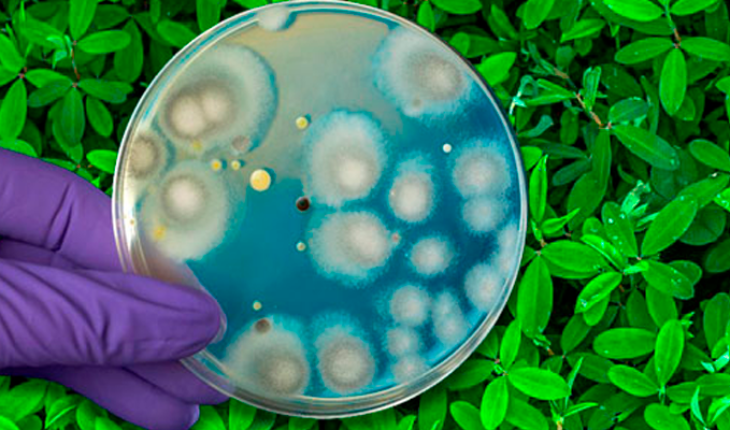Morelia, Michoacan.-the words are combinations of letters that create changes in sounds and meanings. The same thing happens with chemicals in the environment which, to perceive, permit communication between plants and bacteria to establish a relation of symbiosis with mutual benefits, or generates a dynamic competition, and even parasitism when the nutrients are scarce.
In a paper published in Conacyt written by Paloma Carreño Acuña, reported that this is research that has developed the doctor José López Bucio, biological University Professor and senior researcher of the Institute of chemical research Michoacana of San Nicolás de Hidalgo (UMSNH) and Member level III of the national system of researchers (SNI).
The root is the “the root is the organ of the plant that is not visible. It is that is responsible for pick up water and nutrients so that they provide all the Green Party, including the stems and foliage, enabling the realization of almost all of its functions, such as photosynthesis and the production of flowers, fruits, grains and seeds “, world food production base”.
This is possible because root thousands of species of bacteria and other microorganisms, are associated with doctor José López said.
“Leaves trap the sunlight and produce carbohydrates that are an important food. These molecules reach the soil through exudation by the root”.
Sugars, amino acids, organic acids, and mucilage, explains, are used by bacteria, attracted by chemical perception or chemotaxis, events and to dwell in the plant can provide protection against pathogens or contribute to a better adaptation to changes in the environment, such as high temperatures, salinity and toxins present in the soil.
Hormones are cellular messengers in this way, the microbial species help to the growth of plants by releasing hormones and growth factors. The doctor points out that hormones are cellular messengers moving to fulfill different functions or assignments and molecules such as auxins, cytokinins and gibberellins is included among them.
Understand that symbiotic function of round-trip hormones and nutrients made who ask how plants communicate with microorganisms of the roots. To find out, they went to different environments where the plants grow in a disadvantageous position (without water and nutrients), to observe how do them without the hand of the human being.
“We study the roots of plants in unfavorable environments compared to those that grow in agricultural soils, and currently think that enabling growth are microorganisms associated, as that can fix nitrogen from the air and convert it into” nitrate, a fertilizer, or which solubilize phosphate from insoluble compounds.”
They took samples and laboratory cultivated these microbial species, attracting them from the wild to more controlled conditions to understand its operation.
They needed to know who were there — referring to the species of micro-organisms-, how to relate to their natural hosts and with other plants, so it used the Arabidopsis thaliana, a small shrub that can be grown in Petri dishes, and There same placed the bacteria to observe the behavior during interaction.
They found that there were different species of bacteria that increase the growth of the root and the production of biomass, thus concluded that understanding communication with agencies of different kingdoms would be a valuable tool to generate more agriculture charity and thus avoid the use of pesticides and reduce agro-chemicals.
How do they communicate?
Communication involves several elements: nutrients such as phosphorus, nitrogen and iron are very important, mentions. “Are like coins for change, depending on their availability is that it generates a relationship of mutualism or competition”.
The scarcity of nutrients is expensive, since microbial populations and plants will not grow as well because they should spend their energy on defend themselves and compete for the few resources that exist.
“It is a relationship that is quite similar to the economic dynamics of humans, occurring based on the scarcity or abundance relationships of mutualism or competition. Communication in nature represents a true language. As well as animals communicate, plants make it with other congeners and their micro-organisms. Dolphins use their language to hunt, the herbivores to escape predators”.
And that language changes according to the geographical conditions, origin of species, degrees of interaction and stimuli from the environment.
The communication of plants is based on the reception and broadcast of words, involving elements such as scents and other diffusible substances recognized by the bacteria, and they become indicators of the presence of nutrients. This is possible because they travel very fast and can be received by its neighbors to react to stimuli and harassments of the environment, sometimes even at the population level.
The alphabet of their language depending on the combinations of molecules that are generated, is the signal that is emitted.
“The signals can be friendship, i.e., molecules will allow growth and interaction, or can be alert.” They have that observed under the microscope, closer or away bacteria from the root and observing if it allows colonization or growing.
The combinations are endless and can generate different reactions, the same thing happens with the arrangement of letters, sounds and pronunciations in the words of human beings. Why the combination of molecules might be as the alphabet of the language by which plants communicate with themselves and with other agencies.
“It is an extremely rich language. We have studied the molecules known as ciclodipeptidos and alkamides, are very small and reported more than 800 variations, with this we can imagine the abundance of possible combinations in the environment”.
And he says that decoding the communication it can impact on one of the most important human activities, agriculture.
With the investigation of the doctor it has been discovered that this language allows an adjustment to the processes of growth and development of crops, resulting in a higher crop yields. Again under the microscope, it is clear to the doctor that “depending on the type of information that emits a root, changes the conformation and structure of their microbiomas”.
Language affects the behavior as well as encourage or limit the growth, the researchers noted that the exchange of substances generates changes in the behaviour of the plants.
“The behavior is a response to a stimulus. Define if misbehaves or is an exercise in thinking, decide, know what it takes, this is the way in which human beings exist and studies to understand individual and collective decision-making”.
The doctor confirms that this same exercise of “decision making” is made by plants and bacteria. They did a series of tests to six different to a same bacterium Achromobacter plants.
Is observed to move it to the root of the Arabidopsis, six individuals react differentially, grow while they build their architecture, moving by the space available, but when he is inoculated a vegetable variant in the communication, now the six individuals react identically, clearly indicating a collective behavior.
This is important, as demonstrated by Darwin, genetic variability is a property of the species that it allows them to adapt and survive, an aspect that is tremendously modified by micro-organisms.
They concluded that each plant reacts as an individual, having particular and behaviours different to the stimulus that is perceived. “This kind of reaction shows us the coincidences between the transmitter with the receiver, as if both speak the same language”.
In this case, the timing of the response was due to a genetic mutation suffered by plants, which generated that before the bacteria all behave in the same way. “The root, is clear that all perform the same movement, here the phenotypic plasticity has been lost”.
They then observed two behaviors: each individual does something distinctive when it interacts with Achromobacter.
All individuals do the same if the communication capabilities of the plant is altered.
In the second case there is an implication: “If the stimulus that is applied is negative, means that all individuals of the population will be affected”.
The place that they occupy the plant doctor talks about the importance that have plants in the development of the world as we know it.
“They are the primary producers of the food we eat. They allow us to obtain directly or indirectly many satisfiers as meat, milk, hides, fodder and seeds being the primary input of livestock”.
Very recently it has begun to study plants communication with other organisms such as fungi and bacteria that live in their tissues and modulate its growth dynamics.
A plant has different bodies, but two main can be distinguished: the green part that is exposed and hidden part that is the root.
Its importance goes beyond what we know about them, since they can be used to answer questions of the natural world to be everywhere: terrestrial and aquatic environments. We cannot ignore that they are in charge of providing the necessary conditions for the uptake of water and the oxygen we breathe.
“As human beings we need minerals to be able to carry out our functions, plants require nitrogen, phosphorus, calcium, potassium and iron, among othersto do so”.
Those elements obtained them from the ground using its roots. The doctor explains that when they are well nourished they produce a good amount of biomass, which are profitable to satisfy the food chain.
Talk about processes of development in plants is prevailing in a world where the population grows at such a high speed, envisaged that in the next few years the population will reach 10 billion people that will need to be fed.
This reality coexists in a world where resources are more scarce everyday and less fertile soils. The investigator said: “we don’t meet that need if we don’t generate conditions for environmentally friendly and highly efficient agriculture, that is the importance of understanding the chemical language of plants and microorganisms”.
Source: Conacyt
translated from Spanish: The alphabet to communicate with plants and bacteria
September 2, 2018 |





